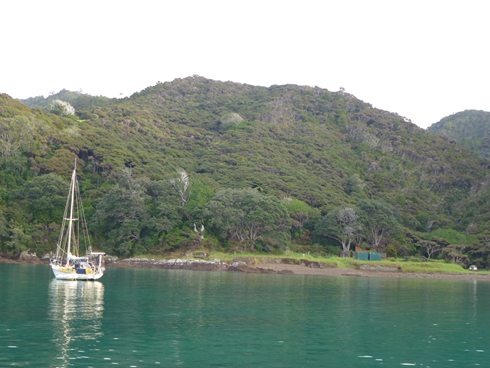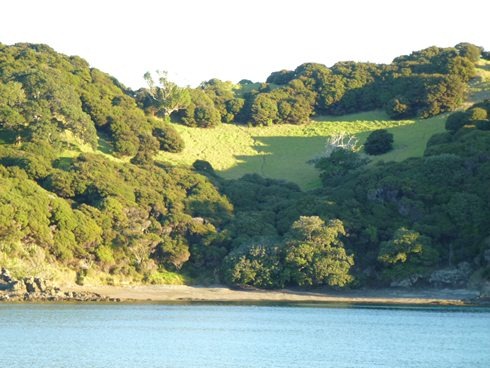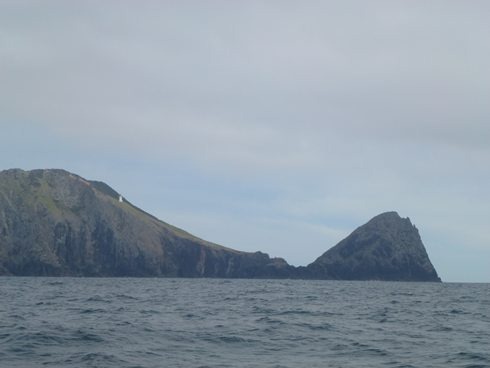1 June 2013 – Itching to be Gone but Stuff Keeps Happening

|
35:19S 174:07E 1 June 2013 – Itching to be Gone but Stuff Keeps Happening We departed Marsden Cove as planned on the morning of Monday 13th April and motored up river to berth in Riverside Drive marina – fairly close to the centre of Whangarei. There were several things we knew we had to sort out before departing for Fiji – as soon after 1 May as the weather gods permitted. We’d noticed just before departing on our NZ road tour that the control panel which controls the hydraulics to the backstay, baby stay and boom vang had become very stiff and needed professional attention. It turned out that that had to be sent to Auckland. Meanwhile, given plans to sail to Indonesia, Singapore la, la, la, we’d understood that we’d need an active AIS rather than our fitted passive AIS receiver because Singapore insists on it. AIS is a magic device which results in a symbol appearing on your chart plotter showing the position, name, call sign, description, speed, direction of travel etc of any vessel within VHF range equipped with an AIS transmitter. That is most commercial ships at least. Many yotties fit only receivers – being more concerned about knowing where the big, fast, often apparently blind and therefore dangerous stuff is than broadcasting their own positions to the world. But, that’s not on in Singapore. So, a new AIS set had to be sent from UK – the alternative of paying NZ crazy prices for such equipment being quite out of the question. On our way up river from Marsden Cove we found that the auto-pilot had decided not to work. We switched to the standby auto-pilot and all was sweetness and light but it did mean that the primary auto-pilot computer had to be sent to Auckland for brain surgery (fortunately under warranty). At least it’s possible to replace a dud brain for a good one in a course computer. Wish the same was true for us. So, we obviously had a bit of time to kill whilst all that happened. We were berthed next door to a chap called Graeme Wilding (‘Ding’ to everyone but his mother, apparently) in a Sweden 50. He’s a Lloyd’s surveyor. Probably as a result of that upbringing it appears to be anathema to him to see a boat alongside in a marina whilst her crew lounges around shooting the breeze and sipping beer. Obviously, they should be tearing the boat apart. So, conscience suitably pricked, Jon responded to a suggestion to “Pop the windlass off and service it”. This turned out to be rather more of an undertaking than the term “popping” might suggest. Getting the cable drum, gypsy and all that above deck stuff off was a piece of cake. It’s all in the anchor locker and readily accessible. However, the meaty gearbox and attached equally meaty electric motor, all of which is connected to the above-deck stuff, are suspended from the roof of the chain locker in what is a most inhospitable environment for machinery, electrics and human beings. So, naturally, most things that look as though they should unbolt easily won’t if they’ve been there for any length of time, unless whoever installed the whole thing in the first place took pretty rigorous precautions. And, rarely do they do that. Moreover, the chain locker on Arnamentia is one of the least accessible spaces aboard. After a lot of wriggling you can get your head and one arm in there and it will take an equal amount of wriggling to extract yourself. So, any unbolting action likely to result in a large lump of metal obeying the laws of gravity whilst your head is directly beneath it needs to be carefully considered. However, all was eventually removed without much injury to body or pride and delivered to the boat yard workshop for a dose of oxy-acetylene to free up the recalcitrant nuts and bolts before the gearbox and motor could be stripped and cleaned. On reassembly we took all the measures that it would have been nice if the installer had taken in the first place to ensure that things came apart more easily next time. Hammerite paint, Duralac jointing compound and the whole electric motor assembly wrapped in lovely, greasy Denso tape. Pretty it ain’t but if you’re looking for beauty, there are many better places to look than Arnamentia’s chain locker. Finally, all now accomplished, we set off from Riverside Drive marina (marvellous place by the way with a real community feel to it) a little before high water on the morning of Sunday 12th May, recalibrated our repaired auto-pilot on the way down river and paused overnight at Marsden Cove. Monday 13th May saw us depart at a pretty civilised 0900 and motor in almost flat calm conditions 50NM to an idyllic cove, sporting an abandoned whaling station, at Whangamumu (don’t you just lurve these place names?).
Whangamumu Harbour, our only neighbours there and the remains of the whaling station
Another aspect of Whangamumu – the whole harbour is accessible only by sea We were now around around 25NM from Opua (a few hours’ motoring the next day to round Cape Brett) where we intended to wait the necessary few days for the right weather conditions for departure.
Majestic Cape Brett on the southern side of the Bay of Islands entrance
The Hole in the Rock off Cape Brett – whizzing through by boat is a popular grockle day trip Typically, at this time of year, good weather windows for a passage north open immediately after a low pressure system has tracked through the area. That happens at something like 5 to 7 day intervals. Pick the right moment and you’ve got the advantage of a slingshot to get you north quickly before the next low pressure system materialises to try to spoil your day in a few days’ time. With luck, by the time the next low arrives it will pass south of you. That’s the theory. Reality is sometimes a little different. Ah, but you just knew that getting away wasn’t going to be that simple. Didn’t you? Whilst motoring up towards Opua from Marsden Cove we’d noticed that the rudder’s lower bearing was leaking. And we’d spent a small fortune sorting out that bearing in Whangarei. A call to Whangarei Engineering resulted in their assuming that it was their fault and offering to despatch their boys to sort out the issue at their expense in Opua (an hour’s journey by road). Very decent of them, it has to be said. So, Arnamentia came out of the water again – in Ashby’s boat yard in Opua – and two Whangarei Engineering chaps arrived. The more experienced of the two gave the rudder a serious shaking at right angles to its axis and it immediately became apparent that the leak was almost certainly not passing through the bearing but around it. The bond between the hull and the bush through which the rudder stock passes had become loose. Shake the rudder aggressively and the bush moved slightly. Hm – therefore nothing to do with the work Whangarei Engineering had done. So, we dropped the rudder and the Whangarei Engineering chaps went home to await the moment when we’d refit it. The rudder’s lower bush is a stainless steel cylinder about 8” long and around 6” external diameter in most places but significantly waisted and flared at various points along its length. It passes through about 5” of pretty solid fibreglass which bonds it to an almost indestructible plastic tube around it and there is something like a 1cm gap between the outside of the bush and the inside of the plastic tube. Not that we knew any of this before we’d started excavating – of which more in a moment. About 2” of the bush pokes out of the bottom of the hull. The top of the bush is accessed from the lazarette. The lazarette is a little more comfortable to work in than the chain locker but not much. In principle we needed to cut out the bush and re-glass it in again. Easy peasy? No, no. The only way of cutting the bush out was to use a long drill bit from underneath to drill and scour out the glass around it and do the same thing from the top. That took 3 days and trashed as many long drill bits. As we approached the point at which excavations from top and bottom looked about to meet up we stopped. It had occurred to us that cutting the bush out was one thing; getting it back properly aligned was quite another. The slightest alignment error would result in our not being able to refit the rudder. The original boat builders would have had a pretty impressive jig – and detailed drawings - to get it right. So, we paused while the excellent GRP man from Ashby’s boat yard re-glassed the portion of the bush now accessible from the bottom before completing the job of drilling and scouring down from the top until he hit new material. Then he re-glassed working from the top. When the Whangarei Engineering chaps re-appeared a week after their first visit, the rudder went home without a murmur. That accomplished, we re-launched Arnamentia on Thursday 30th May and scuttled off back to Opua marina to await our weather window. Whilst out of the water in Ashby’s boat yard we’d moved into another backpacker hostel, except that one could hardly call Andrea’s very pleasant little house overlooking Opua harbour, a hostel. We felt much more like paying guests with everyone in the house mucking in, preparing food and sharing it. With the worry over the rudder, it was lovely to be able to get away from the yard and relax by Andrea’s wood burning stove – yes, it is winter here and very chilly at times. And, Kiwis don’t believe in double glazing or central heating and mostly live in wooden houses. We even managed a couple of outings, firstly to the quiz night at the yacht club where we joined with Andrea and some of her friends to form the Rovers (Russell, Okiato and Opua Veritables!) and managed to scrape a win. That’s three in a row now – so no pressure! The other outing was to hear the Russell Ukulele Orchestra; fortunately they were far too proficient to need Jon’s services! George Formby’s “Leaning on a Lamp Post” wasn’t in their extensive repertoire (probably a bit too obvious whilst the Kinks’ “Dedicated Follower of Fashion” did feature – a good move - and “Ain’t She Sweet” didn’t – surely a mistake). A bass guitar, a mouth organ, a mandolin, a maraca or several and some pretty good voices provided for great variety and made for a thoroughly enjoyable evening. Andrea’s place is the other side of the harbour from the marina and boat yard so we had to make use of the local equivalent of the Gosport Green Bucket. A great service with very flexible skippers – they’ll reverse back to let you drive on if they’ve only just moved off. From time to time the clippies, who are usually training for their skipper’s ticket, are allowed to take the helm and practice parking – they may take a little longer but no-one minds – life is definitely more relaxed here than in Auckland. The ferry even acts as a litter picker upper and one gets used to the front ramp being lowered mid passage and the clippy going forward to scoop up stray floating objects!
The Opua – Okiato/Russell ferry – a great little workhorse So, here we sit, poised to depart – or nearly so. We’ve had one or two electrical and electronic issues to resolve since arrival in Opua but in the main we’ve sorted these out without too much pain. The battery charger is a bit of a worry at the moment – it began misbehaving a little and was sent to the doctor in Auckland. It’s now back but is still apparently behaving a little oddly. So, we now need to investigate whether the problem lies with it or the massively expensive domestic batteries. And, once we’ve got the answer, work out what to do about it. As far as future plans are concerned, we’ve decided that we are not going to rush to get to Darwin or wherever by late July to join the Indonesian Rally and end up in Thailand at the end of the year. That will be next year’s project. We haven’t spent nearly enough time in Fiji and we haven’t seen either Vanuatu or New Caledonia. So, the plan now is to tick them off this season and return to NZ in late November or December. Next year looks like the Great Barrier Reef – the Coral Coast – and then up through Papua New Guinea, Indonesia, Singapore to Thailand. Whatever. |




